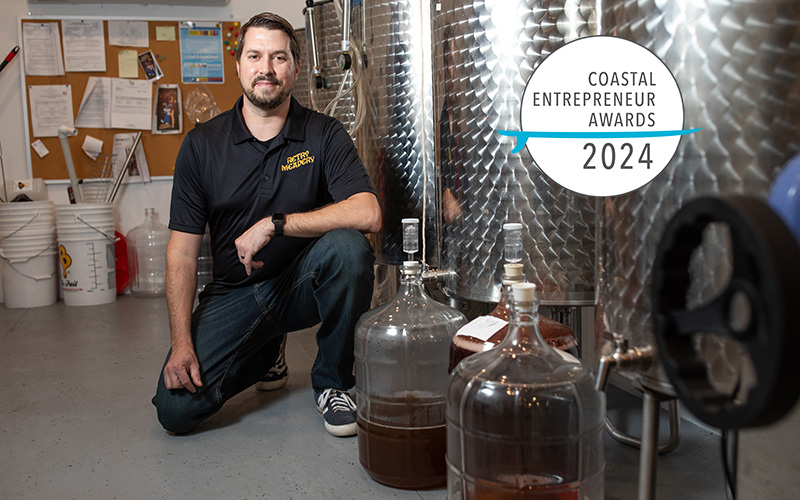Providing safe, quality drinking water to our community is a core mission at Cape Fear Public Utility Authority (CFPUA). It’s a job that includes state-of-the-art treatment and intensive laboratory analysis and monitoring that starts at our intakes on the Cape Fear River and at groundwater wells and continues along multiple points throughout more than 1,000 miles of pipes that distribute water to our customers.
Our community’s drinking water is regularly tested for a wide range of potential contaminants, from pathogens like E. coli to man-made substances such as GenX and other per- and polyfluoroalkyl substances. This month, I want to focus on one of the substances we monitor – lead – and our successful efforts to keep it out of our customers’ drinking water/
Health effects from lead contamination are well-known, its potential for harm brought to light most recently by the 2014 crisis in Flint, Michigan. The U.S. Environmental Protection Agency (EPA) warns that lead can harm mental and physical development in children and cause cancer, heart disease, and other severe health problems in adults.
The most common sources of lead in drinking water are old plumbing fixtures in customers’ homes and businesses that can leach lead into water. To help prevent this from occurring, water utilities employ corrosion-control programs. At CFPUA, we add orthophosphate, which is recognized as safe by the U.S. Food and Drug Administration. Orthophosphate is added after treatment and forms a protective coating inside pipes and plumbing fixtures. The EPA introduced regulations to prevent exposure to lead in 1991 with its Lead and Copper Rule (LCR). The Lead and Copper Rule (LCR) requires water systems such as CFPUA to test water sampled at homes of potentially susceptible customers according to a mandated schedule. I am pleased to report our results show we consistently meet EPA’s compliance requirements, which is strong evidence that our corrosion-control program is working as intended.
In 2021, EPA revised the LCR and, in November 2023, published a draft of Lead and Copper Rule Improvements, which is currently open for public comment. The revision and improvements introduce a significant number of new regulations and make changes to existing ones, including reducing the lead “action level” from 15 micrograms/liter(ug/L) (equivalent to parts per billion) to 10 ug/L and changing where and how samples are taken. You can find out more about the LCR revision and improvements on EPA’s website.
A major component of the revision and improvements is a requirement for public water systems to create a publicly accessible inventory of water service lines in their service areas. Service lines are pipes that extend from water mains to water meters (the public side maintained by CFPUA) and from water meters to customers’ homes or businesses (the private side maintained by the property owner). The new rules require water utilities to determine what materials the public and private service lines in their systems are made of and replace any lines found to be made of lead or galvanized pipe that is preceded by a lead pipe.
In 2020, recognizing the LCR revision was coming, CFPUA staff began poring over historical records, dating back to 1895, to look for evidence of potential problem areas. They also tapped into the knowledge of those who maintain our water distribution system and may have encountered areas warranting closer, hands-on inspection.
CFPUA has more than 70,000 service accounts. In many cases, the materials composition of service lines to these accounts can be determined by checking available records. Such information may be unavailable or less reliable for older connections. In these cases, one way to find out is to visit the address, dig a hole, and examine the service line. Fortunately, this process has been underway at CFPUA for more than three years.
Staff and contractors first examined public side service lines at about 7,500 addresses in the oldest part of our water system. Among other things, this work corroborated the materials information in our historical records. When EPA released its final rule revisions in December 2021 it included an unanticipated requirement for water systems to identify the materials used in customers’ side of the water service line as well. To accomplish this, CFPUA is contracting with multiple survey firms to examine private-side water lines. We also are harnessing the power of machine learning, a branch of artificial intelligence that uses statistical algorithms to develop reliable predictions based on available data, helping to fill information gaps and prioritize areas for further investigation.
To date, no lead service lines have been found in the CFPUA system. In addition, our early work to examine water service lines played a key role in recently securing $4.16 million in Bipartisan Infrastructure Law funding administered by the N.C. Department of Environmental Quality. This funding will be used to replace approximately 300 galvanized service lines that are suspected to have lead “gooseneck” connectors.
Utilities such as CFPUA are expected to have their initial service line inventories complete by October 16, 2024, and to annually replace at least 10 percent of any lead service lines in their systems. Thanks to the proactive work by staff, CFPUA is well positioned to meet these important requirements.
Beverage Manufacturer To Occupy Former Tru Colors Facility In Wilmington
Audrey Elsberry
-
May 6, 2024
|
|
Wilmington Leaders To Consider Skyline Center Lease, Debt Payment
Emma Dill
-
May 6, 2024
|

Backed by years of biologics formulation development for mRNA vaccines, monoclonal antibodies and peptide drugs, Ying Wang, associate profes...

Landon Hill's Local Catch app looks to streamline communication between stakeholders in the local fishing and seafood industry....

As Southeastern North Carolina’s only commercial mead maker, Retro Meadery has given many local customers their first taste of mead – a ferm...
The 2024 WilmingtonBiz: Book on Business is an annual publication showcasing the Wilmington region as a center of business.
